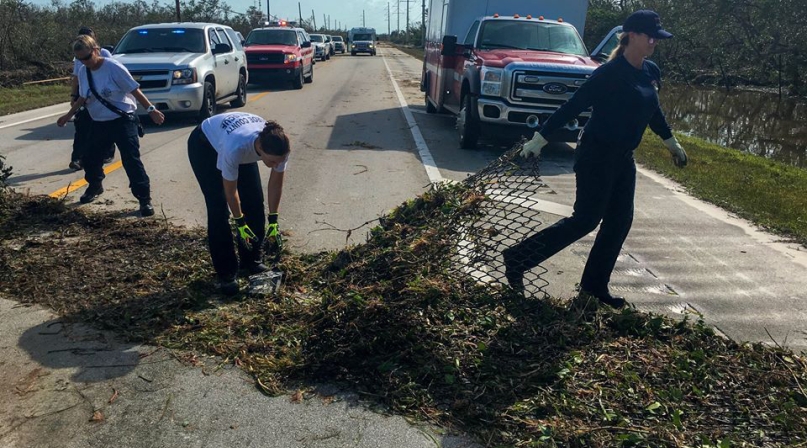Counties’ hurricane preparations extensive, varied

Hurricane recovery poses challenge for counties
Counties and parishes that took a hit from two monster storms — Hurricanes Irma and Harvey — are digging out from flooding, high winds, loss of power and more in Florida, Texas, Louisiana and elsewhere in the Southeast. Hurricane Irma claimed at least 26 lives on the U.S. mainland, The Associated Press reported.
Do More
Anyone interested in assisting should go to: FloridaDisasterFund.org.
Learn More
Wildfires put lives, health, ecology, property values at risk
Much of Florida, about 6 million homes across the state — including the Keys in Monroe County— was without running water and electricity and cellphone service last week after getting slammed by Hurricane Irma Sept. 10.
Monroe County Commissioner Heather Carruthers, who rode out the storm with her family in Orlando, helped coordinate recovery efforts after her county took the brunt of the storm, by participating in four hour-long conference calls each day with federal, state and local emergency management officials. The hurricane made landfall in Monroe County packing 130 mph winds.
Social media played a crucial role for counties during the hurricanes and their aftermath. Carruthers and other county officials kept residents updated by posting messages to the county’s Twitter and Facebook pages after the conference calls and after speaking with emergency workers on the ground via satellite phone. A day after the storm, the county let residents know that running water would be available for just two hours. The post and other subsequent messages received thousands of “shares” on Facebook and hundreds of comments. Another post let residents know that county inspectors were out making damage assessments. “It always comes down to communication,” Carruthers said.
FEMA estimates one in four homes in Monroe County were destroyed and about 65 percent were damaged, FEMA Director Brock Long said at a news conference.
The county had prepared for days leading up to the massive storm, evacuating the area and offering bus service to a shelter at the Miami-Dade County Fairgrounds; Carruthers said she was surprised that about 10,000 of the area’s 79,000 population decided to stay put. “We know there are some stubborn people who think they can stay behind,” she said. “Everyone in the Keys becomes an amateur meteorologist.”
The timeline for some county and residents’ prep work before the hurricane hit included:
The county evacuated 500 inmates from the jail in pre-dawn hours Sept. 9 to Palm Beach County, Fla.
Animals from the Monroe County Sheriff’s Office Animal Farm — including ponies, snakes, alpacas and “Mo” the sloth — successfully weathered the storm in the jail along with some detention staff, deputies and detectives.
County trash centers closed down the afternoon of Sept. 7.
The last flight out of the Key West International Airport was at 5:50 p.m. Sept. 7.
The three hospitals in the county closed at 7 a.m. Sept. 8 to give employees time to evacuate. Patients were evacuated, some of them in a C-130 to a hospital in Alabama.
The county’s special needs residents were taken to Florida International University by chartered bus.
The three Monroe County Trauma Star helicopters were flown to Dotha, Ala.
The county opened four “refuges of last resort” on Sept. 9 at 9 p.m., about 11 hours before the hurricane made landfall, for those who stayed behind, at area schools.
The county’s emergency management team set up shop about 50 miles up Route 1 in Marathon and then relocated to Ocean Reef, which is nearly three hours up Route 1 from the county.
“We have used the Marathon Government Center, turning our chambers into a control room,” Carruthers said. “But it is not Category 5-rated and though it’s on the second floor, the area around it can flood in a bad storm. That’s why we moved the county emergency management team to Ocean Reef during the storm.”
Carruthers said she is heartened by the messages she has received from other county officials from outside her region and for the speedy response from state and federal officials to help the county rebuild after the storm. “It’s been really encouraging,” she said.
Lee County, Fla., officials also made good use of social media, by asking residents to post information on businesses they saw open, after the storm. Residents were quick to respond, posting information on gas stations, grocery stores and where you might find ice or where they were experiencing extra-long lines. The county posted information about which pharmacies were open, how to treat intersections where traffic signals weren’t working and trash pickup information. The county also asked residents to stay off the roads so emergency personnel could do their jobs.
In Collier County, Fla., where the hurricane made a second landfall, officials used Twitter to get the word out, asking residents to report open gas stations to GasBuddy.com and report downed power lines. The county posted aerial footage, recorded by the county sheriff’s office, of flooded neighborhoods.
In Leon County, Florida Association of Counties’ staff were embedded at the state emergency operations center where they served as a liaison to the counties.
Virginia “Ginger” Delegal, executive director of the Florida Association of Counties, said that counties’ hardest work is ahead of them. “They know how to prepare pre-storm and during, but after is when the challenges present themselves,” she said. “Recovery afterward is incredibly unpredictable.”
Temporary housing for those left homeless, especially from mobile home parks, will be a particular challenge, she said. The tourism industry will rebound, she noted. “The tourism industry is resilient and will bounce back.” She said the BP oil spill was a bigger challenge.
Florida Gov. Rick Scott (R) has been holding evening calls with county officials and shared his cellphone number with them, Delegal said.
Delegal noted that there was a lot of teamwork between Florida counties across the state before, during and after the storm, as counties opened their shelters to other counties when the storm shifted its path and took on hundreds of inmates that were evacuated, as Palm Beach County did for Monroe County.
After clobbering Florida, Tropical Storm Irma headed north to Georgia and South Carolina, where coastal counties were inundated with flooding.
Knee-high floodwaters could be seen gushing through the streets of Charleston County, S.C. on Sept. 11 and more than a million were left without power in Georgia.
Meanwhile, in Harris County, Texas, county Judge Ed Emmett is calling for sweeping reforms of the area’s flood control strategy in the wake of Tropical Storm Harvey, which flooded more than 100,000 homes in the area when it hit Aug. 25.
Residents in Texas and Louisiana continue to dig out there, after three landfalls that left a climbing death toll and thousands stranded when more than 50 inches of rain fell, flooding the region.
“It’s the worst flood we’ve ever seen, for sure,” said Gene Terry, executive director of the Austin-based Texas Association of Counties, shortly after Hurricane Harvey had decimated coastal counties.
“But this ain’t our first rodeo so to speak — we’re gearing up for the next 10 days.”
In Harris County, Emmett has laid out options including accelerated buy-outs of flood-prone properties, creating a flood control district with neighboring counties and seeking authority from the state to levy a sales tax to pay for the initiative.
“Why do we keep fixing the same problem over and over again? It doesn’t make much sense,” said county spokesman Joe Stinebaker. Emmett’s No. 1 priority is now “dealing with this all too-common flooding.”
All of the options would require federal and state help, Stinebaker said. “Local folks are not going to be able to afford this. We need the feds and the state to step up or remediate again.”
State lawmakers “are also going to have to step up,” he said, to give Harris County, population 2.5 million, some kind of authority to regulate building in the floodplain. Currently, Texas counties don’t have that ability.
Attachments
Related News

White House launches federal flood standard support website and tool
On April 11, the White House launched a new website and mapping tool to help users with the ongoing implementation of the Federal Flood Risk Management Standard (FFRMS).

U.S. Army Corps of Engineers publishes memo on protection of non-jurisdictional waters and wetlands
U.S. Army Corps of Engineers memo directs civil works actions on water and wetlands in response to recent Waters of the United States (WOTUS) changes.

As disasters increase, counties must invest in mitigation
Disasters are becoming more frequent, more severe and more costly, and counties, parishes and boroughs are on the front lines — where the immediate response is handled and where the personal impact is felt.
